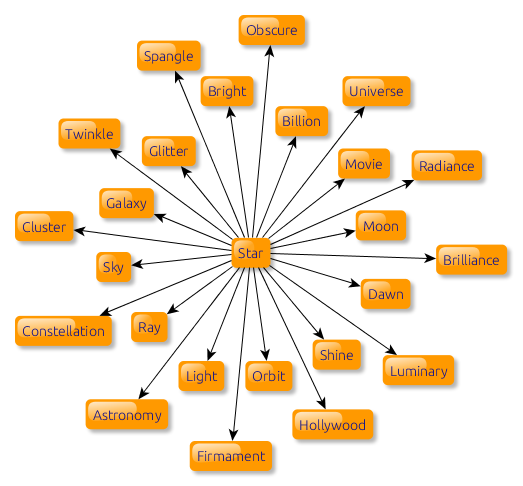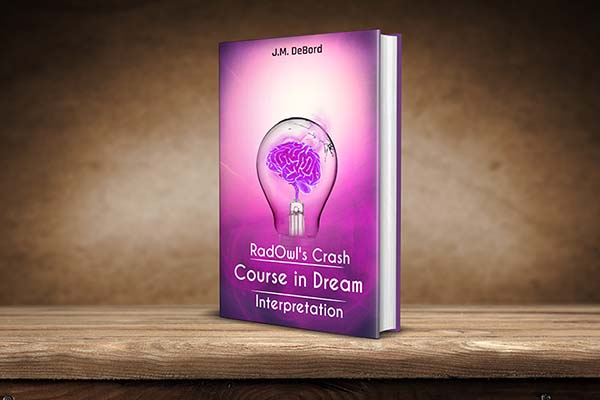
Association method is a popular tool for dream interpretation because it leads intuitively to the meaning of the symbolism. Associations are your thoughts, feelings, emotions, memories, and perceptions related to a symbol, subject, or idea raised by a dream.
Association is the most common way for dreams to create symbolism, so we’re not just talking about a method of dream interpretation; we’re using association to deconstruct how dreams create symbolic meaning. At Dream School, we keep it simple and just say “associate.”
Associate is simple: Boil down a dream’s detail to a word, phrase, or image; focus on it; what comes to mind that you associate with it? When your association leads to a correct answer it feels right.
Remember simple fact #1: you already know subconsciously what your dreams mean, so interpretation is a process of reminding yourself what you already know. Associating helps you remind yourself by thinking intuitively, off the top of your head. It prevents hindrances such as avoidance, denial, rationalization, and over-thinking, and helps you communicate with subconscious parts of your mind.
Association examples
- Football is associated with team competition and brain damage.
- The color purple is associated with royalty and bruising.
- The moon is associated with the tides, femininity, and astronauts.
- The circle is associated with completeness and groups… and the moon.
- The cross is associated with Christianity and crucifixion.
Those associations are by no means the only ones. They’re not everyone’s associations. They’re simple examples to get you started. The examples show you the wide spectrum of possibilities that can come to mind when you associate.
There are no right or wrong answers. However, associations have to circle back to the dream in order to be useful. You could associate astronauts with the moon and the moon with cheese and cheese with mice, and it won’t give you insight into what an astronaut means in your dream.
Like a monkey going from branch to branch of a tree, associations reach out from their starting point to connect with outlying ideas. For example, the cross is associated with Jesus, who is associated Christianity, which is associated with church, which is associated with religious authority. In a dream that features a cross, any or all of those associations could be the basis of its symbolism. To interpret what the cross means, make associations and connect them with the details of the dream-story and your feelings.
King context
Context is king for understanding dream symbolism. A dream rarely presents a symbol by itself. Instead, it’s part of a story. Story context and personal context tell you what a symbol means.
For example in a dream, children throw rocks at a cross and it breaks. That gives us context to understand which association is used as symbolism for the cross. In the example above I gave “Christianity” and “crucifixion” as two examples of associations. Now add “authority,” “religion,” and “belief system” to the list and consider the possibilities for what the cross means in context:
- Breaking the hold of an authority structure (the cross breaks, and children are known for chafing against authority).
- Breaking free of a Christian belief system or any belief system, but especially one built atop authority.
- Arguments or insults against religion (based on the symbolism of throwing rocks, and the association of the cross with religion).
- Disrespect for authority or an authority figure.
This is only the beginning though. The potential for symbolism branches out far and wide to include specific personal associations with the cross and what it represents. Your personal experience and feelings about church, Jesus, Christianity and authority can come into the picture. So do cultural and group associations, such as Christianity being widely viewed outside Western culture as a conquering religion that subjugates militarily-weaker cultures. Ask Native Americans or Muslims what they think of the cross and what it represents to them!
The imagery could even symbolize a David vs. Goliath situation. The children — the weaker force — break the stronger force’s power, and David used a rock to fell Goliath, the stronger force in that scenario. It all connects back with the image of children throwing rocks at a cross and breaking it.
Highly personal associations can be used to create the symbolism, too. For example, imagine the person who, as a child, was bored to death in church. They associate the cross with the routine church services of their youth. Now, use that association in the context of the dream and it raises the possibility of the imagery meaning “break a (boring) routine.” In this scenario, the association with childhood is the reason why the dream puts the rocks in the hands of children. Or perhaps it’s based on children having more time for fun.
On the next associated branch we find possibilities for this imagery to mean “rebellion,” like a child rebels against going to church. Jesus was a rebel, after all.
On top of everything already mentioned, we can also consider the cross’s associations with spirituality, personal salvation, forgiveness, sacrifice, sin, and torture.
Notice how we branched out from general associations to personal ones. That subject is next.
General and personal associations
Dreams create symbolism from general (group or cultural) and personal associations. In the above example, you think of general associations with the cross common across groups or cultures. Then you branch out to your personal thoughts, feelings, memories and perceptions. You think of personal experience and what a particular detail of a dream means to you. Below, I provide several examples of dreams interpreted using personal associations.
Archetypal symbolism and association
Archetypal means “the same meaning across time, groups, and cultures.” For example, Mom symbolizes life to everyone, everywhere. Everyone is born of a mother, and no matter how well your mom lives up to the role and what time period you live in, you are aware of the archetypal symbolism. It’s ingrained in you from birth. The association between mom and life is archetypal.
Associate freely, but don’t wander too far
Association is brainstorming. Some of your ideas won’t feel right or lead you anywhere, but hitting the mark gives you a snap of recognition. You subconsciously know what the symbolism means, so making the right association is like remembering something on the tip of your tongue. Snap!
Association technique allows your intuition and feelings to speak, to end run around your filters. It bridges the gap between what you know consciously and what you know subconsciously.
Dreams use associations to cast a wide net that captures related ideas. For example, dogs are associated with friendship. Using that association, a dream could use a dog to symbolize a specific friend, or the subject of friendship. Friendship is used beyond human and animal relationships to describe relationships such as “friendly nations.” It’s used to describe certain personalities and conditions that are favorable (a “friendly sea” or “the friendly skies”). Just one simple association gives you much to consider.
But remember, when you associate it must circle back to the dream.
You build a personal library of associations throughout your lifetime from personal experience, exposure, culture, society, and media. You are born with some associations, such as knowing that Mom is Life, and acquire the rest. As you learn and grow, your dreams have more to work with, eventually accumulating many thousands of potential references for use as symbolism. Some associations are ingrained so deeply you won’t know the origins unless you are intimately familiar with the collective unconscious. Some are immediately recognizable.
Practice associating
Word association is good practice to learn association technique used in dream interpretation. So is improv comedy. There are no right or wrong answers, just let the words and ideas flow freely. No judging. No ego. No embarrassment. The point is to get around your filters and other hindrances. To practice word association, try:
Human Brain Cloud
Pick out everyday objects and people and brainstorm associations. Little did I know at the time that the game I played with my friends as a teenager, where we’d see a random person and create a backstory about their life, would help me immensely as a dream interpreter and author. This game has no limits, no rules, no right or wrong. Just brainstorm. You are likely to make unexpected connections and even recognize yourself in how you project onto other people.
Also, note how advertising, media, and marketing use associations to convey ideas, moods, and emotions.
Examples of dream association
Next are examples of dreams interpreted using associations:
The kitten that steals her heart
Attacked by a raccoon
The giant, walking banana
Hey buddy, sell me your boots
In the first example, a dream uses the dreamer’s associations with a kitten to convince her to keep the child growing in her womb rather than abort it (general assocation).
In the second example, a dream uses a childhood experience with raccoons to tell a story about feeling punished (personal association).
In the third example, the color yellow comes into play, based on a stereotype (general association).
In the fourth example, the dreamer’s personal association with his boots is the basis of the symbolism.
Personal examples
Association is the first dream interpretation technique I learned to use. It’s now a valuable tool which helps me to tease out the meaning of dreams that would otherwise be inscrutable. Next, two examples from my dream life.
I’m a dream interpreter in Alaska
In a series of dreams, I’m in Alaska to speak with the locals about dream interpretation. The first dream brings to my attention that I’m north of the Arctic Circle. So not only am I “way out there” in Alaska, I’m “way, way out there.” I remember entering a town and seeing a street vendor behind a table displaying his wares. In a followup dream, I find a bookstore where I’m greeted by the locals who know I am there to give a talk about dream interpretation. The setting is cozy, another way of saying only a handful of people are present, but I feel welcome and honored to be their guest.
I puzzled over these dreams, seeing some parallels with my life at the time, but the meaning and significance were lost on me. Especially the detail about being in Alaska. I’ve never been to Alaska. No one I know lives there.
This dream theme continued to arise and stand out to me. I remembered those dreams more clearly than others, but still, why Alaska? I didn’t use association technique to decode the symbolism until one day I was working in my yard. The dream came to mind and I had an “aha!” moment. Use association, duh. So I ask myself, what do I associate with Alaska? I think “sparsely populated.” Of all the possible associations, that one comes immediately to mind, and I use it to decode the meaning of the dream.
At that time, my first book about dream interpretation Dreams 1-2-3 was on the market and I was using it to gain public speaking engagements. My publicist suggested that I try bookstores and community centers, so I set up the appearances and showed up carrying my “wares”: copies of my book. I was like the street vendor in the original dream. And like the dream where I show up to talk about dream interpretation, there I am at my first workshop, in a small-ish bookstore, confronted by empty chairs. Other workshops and presentations I gave at the time were similarly “cozy.”
In other words, sparsely populated.
I had a few more similar experiences as I made appearances on podcasts and radio programs with small audiences. Sparsely populated.
That’s how the dream uses my association with Alaska to create symbolism.
The most important detail for me personally is my reaction in the dream. I’m happy to be there, and I feel welcome and valued. Doesn’t matter that I’m in Alaska. To this day, I take every opportunity to speak publicly, because I never know when I might win the lottery of life and be approached by someone who can open doors for me. More importantly, I never know when my teachings and insights into dreams might benefit someone.
I’m Putin’s political strategist
I dream that I’m Vladimir Putin’s political strategist. I’m at a desk in a Kremlin office. The office is nothing special, neither is the desk, but I feel good about the role I’m playing. I think to myself, this is all new to me, but at least I know how to strategize.
After a dream like that, most people focus on the unreality of it. I live in Tucson, not Moscow. I know a lot about Putin because I follow world news, but I have no affiliation or connection with him or Russia. So why does the dream put me in the role of being his strategist?
I use association method to help me understand the dream, and the first thing that comes to mind in relation to Putin is master strategist. Say what you will about the man, he’s brilliant when it comes to strategy.
It seems a little too obvious though because in the dream I’m already in the role of strategist. I know that dreams carefully and deliberately choose every detail. So I ask myself, how am I playing the role of strategist? And it comes to me that I’m playing that role as I hash out the details of setting up a business. At the time of the dream I was strategizing. It’s not a role in life I usually play but I do it fairly well. The dream uses Putin as a reference to strategy, then doubles-down on the symbolism by making me Putin’s strategist.
Association is the first tool of dream interpretation you will use in most cases. It gets the juices flowing, gets you thinking intuitively, and most of all it engages you with the dream content. Sometimes a dream is just waiting for you to take interest. It WANTS you to know the meaning and message.
For further exploration:
Using association in the process of dream interpretation, excerpted from my book Dreams 1-2-3.



